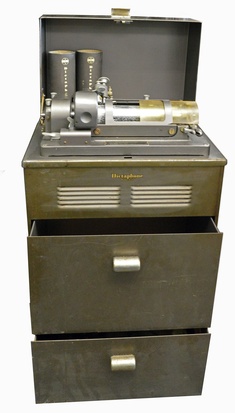Dictaphone Shaving Machine
- Company :
- Dictaphone Corporation of New York
- Gallery :
- Pictures of Dictaphones
The Dictaphone technologies evolved from Thomas A Edison’s Phonograph machine and Alexander Graham Bell’s Graphophone machine. Edison developed these ideas to market the Dictaphone for recording and reproducing speech on wax cylinders. Many large companies like the Pennsylvania Railroad, colleges, and other businesses began to widely use these machines in the early 1900’s. By the mid 1900’s, the dictating machine involved 4 units of equipment that included: the dictating machine that inscribes the dictator’s received messages on to a cylinder, the wax cylinders where the messages are recorded, the transcribing machine that reproduces the words on the machine into sound for the typist, and the shaving machine that scrapes and smooths the dictation from the wax cylinder so it can be reused. A cylinder held up to 1,000-1,200 words and could be reused nearly 130 times.
This particular machine is a shaving machine Cameo model from the 1920’s, manufactured by the Dictaphone Corporation of New York, and patented as early as 1929. On the top of the machine there is a small metal plaque that provides the directions for operation. It reads:
Directions for operation
1 With carriage at extreme left position, open end gate wide.
2 Place cylinder firmly on mandrel and close end gate.
3 Set knife and lock position.
4 Move carriage upright and to extreme right, place carriage gently on rail.
5 Start motor.
6 When carriage has traveled to extreme left additional cuts may be taken by moving carriage upward and to extreme right.
@www.officemuseum.com

